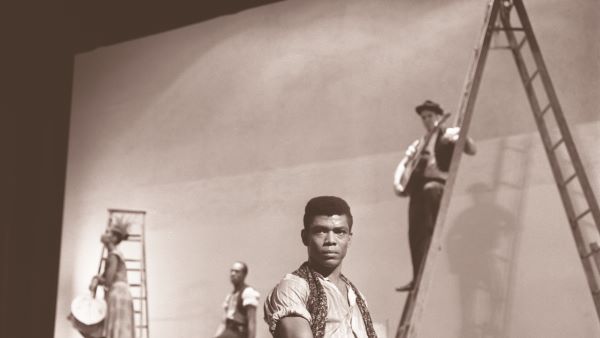
Jamila Wignot’s documentary is a wonderful introduction into the world of the legendary choreographer, but it’s more of an appetizer than a full meal. A remastered interview of Ailey serves as narration, with visuals mostly supplied by abundant clips from his dances and archival footage that depicts life from 1931, when he was born in the rural South, through 1989, when he died of AIDS. Interviews with his colleagues round out his biography, with notables such as Judith Jamison, Bill T. Jones, and Carmen de Lavallade.
The film opens in 1988 with Cicely Tyson presenting Ailey with the Kennedy Center Honor for lifetime contribution to American culture. “Alvin Ailey is Black, and he’s universal,” she says, as the still handsome choreographer looks down from the VIP balconies. (The irony: President Reagan was there that night celebrating Ailey, but had turned a blind eye to the AIDS crisis until tens of thousands had died.)
Ailey was raised by a single mother in segregated Texas during the Great Depression. The black-and-white stock footage of African Americans in these years is striking–children laughing, undertaking chores, and swimming (the Texas Archive of the Moving Image is one of Wignot’s sources). Later, the pair moved to Los Angeles, where a young Ailey was introduced to dance through performances by the Katherine Dunham Dance Company and others. In 1954, he relocated to New York City and studied under Martha Graham and Lester Horton.
Clips of his dancing reveal a graceful and charismatic performer. In 1958, he founded the Alvin Ailey American Dance Theater and debuted Blues Suite, a jazzy number highlighted in the film, along with Revelations, his breathtaking masterwork from 1960, set to spirituals and gospel and inspired by his religious upbringing. Iconic moments in the choreography of Revelations include a tight group of performers with hands reaching in the air, in an effort to rise up.
The troupe goes on international tours, with increasing popularity, and then comes home to the quotidian job of dance practice, with Ailey maintaining the beat, calling out, “1,2,3. 1,2,3. 1,2,3.”
In his voice-over, Ailey discusses the “blood memories” that seeped into his work, the collective memories of parents and grandparents whose suffering and resilience marked his ancestry. Throughout his oeuvre, he conveys the Black American experience in a powerful way.
Testimonials from his peers include comments that the gay choreographer had no partner, just intermittent relationships, but he maintained a close bond with his always supportive mother. Jones relays some of the hardships of his colleague, saying, “Who could love him? Were they loving him, or what he represented? His fame.”
Ailey recalls the early death of a friend, Joyce Trisler, who was once one of his dancers, that jolted him. He realized, “If Joyce can die, I can die. So, I had to live quickly.” He then brought a lover home from Paris. Later, his erratic behavior led to a few months in a mental institution. The details and resolution of these episodes are missing from the film, as are the particulars of his other relationships both personal and professional—and the full trajectory of his career—leaving the documentary feeling a bit scrappy.
Judith Jamison, Ailey’s muse and a longtime dancer in his company, appears in many sensational performance clips. When he became sick from AIDS, he asked her to take over the company upon his death. She assumed the role as artistic director for 21 years. Robert Battle succeeded her, and we see him in present-day segments, preparing for an anniversary event, including the development of Lazarus, a new piece by Rennie Harris that evokes the Black experience and Ailey’s legacy. Ailey Studios on Manhattan’s Upper West Side continues to be a nexus for dance.
With this portrait, Wignot shares a captivating glimpse into the trailblazing choreographer, and though fragmentary, it recognizes dance as his heart and soul and places it center stage.
Ailey screened in the Critics’ Week section at this year’s Tribeca Festival and will open theatrically on July 23, 2021.
















Leave A Comment